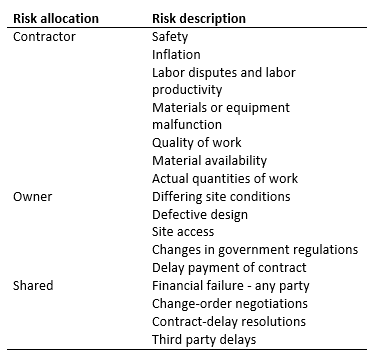Contractual uncertainty and risk allocation
Contents |
Abstract
In order to be fulfilled, civil engineering projects usually entail allocation of huge resources of different types. But in the same time, financing large resources for a project means assigning of great responsibilities. So it is common that a single contractor will not take the whole responsibilities corresponding for a big project, but these will be shared through an ample selection from the multitude of existing types of contracts nowadays.
In the same time, sharing the responsibilities represents sharing the risks corresponding to the specific parts of the civil engineering projects. I personally do show a particular interest towards the manner construction business deals with risk management, risk identification, risk quantification and the way risk is controlled throughout the project and allocated to different parties by means of contracts.
This report will be focused on analyzing different existing types of contracts, how they serve the involved parties and how responsibilities and benefices are shared in order to achieve a common goal. Hereinafter the choice between basic types of complex contracts (lump sum contract, unit rate contract, guaranteed maximum price contract, pure incentive contract, guaranteed maximum liability contract, percentage fee contract, cost reimbursable contract) will be further discussed.
Introduction
By definition, a contract is a mutually binding agreement that obligates the seller to provide the specified product and obligates the buyer to pay for it. So, in the same time, a contract can be seen as the foremost documentation that defines the duties and responsibilities of each party of the agreement. Furthermore, to make the connection with risk management in civil engineering, this may be translated to the fact that by means of contracts, the owner will be the one that allocates risks to one of the other parties. Hence, the choice of a contract plan becomes crucial, as it represents the primary step in the control and allocation of corresponding risks of a project. This will further allow focusing the attention of project management on early identification of risk and uncertainty and highlight those areas where further design, work development, or clarification is most needed.
Risk in construction business
Risk is defined as the chance of an adverse event to happen depending on the circumstances. Risk and uncertainty are part of all construction work regardless of the size of the project. Some factors that carry risk include, for example: complexity, speed of construction, location of the project, and familiarity with the work. When serious risks occur on projects the effects can be very damaging. In extreme cases, time and cost overruns turn a potentially profitable project into a loss-making venture. Cost and time targets are often missed due to unforeseen events that even an experienced project manager cannot anticipate. (Hayes, 1986)
By means of contractual agreement, it is possible that the inherent risk of a specific job to be assumed by another party that has the competence to fairly assess the risk and the expertise necessary to control or minimize it. Shifting tasks to another subcontractors means transferring or sharing the ownership of the risk with them in the following way (Godfrey, 1996):
•having a stake in the benefit or harm that may arise from the activity that leads to the risk;
•responsibility for the risk; accountability for the control of risk;
•financial responsibility for the whole or part of the harm arising from the risk should it materialize.
For a better understanding of possible matters in construction projects, different sources of risk will be presented and grouped, function to their allocation: to the contractor, to the owner, shared, according to a survey published (Roozbeh, 1995- survey).
Basic types of contracts
Having familiarized with the concept of contracts and risk management and how they bond with each other in civil engineering projects, there will be further presented the three basic types of complex contracts existing: fixed-price contracts, cost-reimbursable contracts, incentive contracts.
Fixed price represents the category of contracts that involves a determined total price for a well-defined product. They transfer most of the risk to the supplier, but even so, he is protected against changes generated from sources beyond its control. To the extent that the product is not well defined, both the buyer and the seller are at risk- the buyer may not receive the desired product or the seller may need to incur additional costs to provide it. These contracts are used when a large amount of information is available, being widespread for the procurement of execution work on site. They may include incentives for meeting or exceeding selected project objectives. (PMBOK)
Cost reimbursable contracts involves payment to the seller for its actual costs, plus a fee representing seller’s profit. They are used in high uncertainty situations, when it is possible to determine the type of needed resources, but not the required amount. Also called fee-based contracts, they represent usually the base point in procuring architectural and engineering design services. (winch) Since there exists place for opportunism of the contractor, usually detailed auditing systems are put in place for full cost reimbursable contracts.
Incentive contracts are a hybrid type of contractual arrangement that contain aspects of both cost reimbursable and fixed price type of contracts. They are structured so that to limit the risk of one of the parties relative to the other, allocating the responsibilities more equally, but also to keep a linearity between the estimated actual cost of construction plus a percentage fee and the actual outturn. The common feature of all incentive contracts is that they try to provide positive stimulus within the contract to motivate supplier performance.
Some recommendations for incentive contracts to be productive will be further mentioned:
